Standard Reference Materials for Cement Paste: Part III—Analysis of the Flow Characteristics for the Developed Standard Reference Material According to Temperature Change
Abstract
:1. Introduction
2. Experimental Design and Method
2.1. Experimental Design
2.2. Experiment Method
3. Results of Rheology for Each Material at Different Temperatures
3.1. Results of Rheology for Cement Paste at Different Temperatures
3.2. Results of Rheology for Standard Reference Materials at Different Temperatures
3.3. Comparison of Flow Characteristics of Cement Paste and SRM at Different Temperatures
4. Discussion
5. Conclusions
- Based on the previous study, it was known that the ratio of W/L affects the yield and plastic viscosity and the G/L affects the hysteresis, so by using these relations, we have proposed new formula because measurement systems are changed.
- In consideration of construction environment, changes in the flow characteristics of each mixture of cement paste at five different temperatures (5 °C, 10 °C, 20 °C, 30 °C, and 40 °C) were analyzed. For all the mixtures, the flow characteristics of cement paste tended to decrease following a rise in temperature. Slight changes occurred in the flow characteristics at lower temperatures, but the degree of change was reduced following a rise in temperature, and a nearly constant rheology value was maintained.
- The decrease of the yield stress at high temperatures (30 °C and 40 °C) can be attributed to an increase in the Brownian motion of the particles, which partially weakens the interactions between agglomerates. In addition, this thermal agitation is also favored by the decrease in the viscosity of the continuous phase.
- Moreover, these results indicate that as the temperature increases, the interactions between the particles and the bonding force weaken and the volume increases as the inter-particle distance becomes distant, which leads to a decrease in viscosity. In addition, at low temperatures, the bonding force between the particles is high, and the number of collisions between the particles is high, so they have a high viscosity value.
- Changes in the flow characteristics in SRM mixtures (corresponding to cement paste mixtures) at five temperatures were analyzed. For all mixtures of the SRM, the degree of change in the flow characteristics demonstrated a tendency to decrease following a rise in temperature, similar to cement paste. The degree of change in flow characteristics was reduced following a rise in temperature, and a consistent rheology value was maintained at higher temperatures.
- The tendency of changes in the flow characteristics of each mixture of cement paste and SRM following a temperature change was compared. For all mixtures, a similar tendency of change was displayed. At lower temperatures, a high rheology constant value was obtained, but at other temperature conditions, a consistent rheology constant value was obtained.
- Succinctly, both the cement paste and newly developed SRM demonstrated a tendency of low sensitivity to temperature change in flow characteristics. Such a result indicates the usefulness of the newly developed SRM as a material that can represent a certain flow performance under a construction environment, especially in various temperature conditions.
Author Contributions
Funding
Conflicts of Interest
References
- Ferry, J.D. Viscoelastic Properties of Polymers; John Wiley & Sons: New York, NY, USA, 1980. [Google Scholar]
- Scott-Blair, G.W. Survey of the rheological studies of food materials. In Theory, Determination and Control of Physical Properties of Food Materials; ChoKyun Rha, D., Ed.; Reidel Publishing Co.: Boston, MA, USA, 1975; pp. 3–6. [Google Scholar]
- Merrill, E.W. Rheology of blood. Physiol. Rev. 1969, 49, 863. [Google Scholar] [CrossRef] [PubMed]
- Martin, M.D.; Ormaetxea, M.; Harismendy, I.; Remiro, P.M.; Mondragon, I. Cure chemo-rheology of mixtures based on epoxy resins and ester cyanates. Eur. Polym. J. 1999, 35, 57–68. [Google Scholar] [CrossRef]
- Yasutomi, S.; Bair, S.; Winer, W.O. An application of a free volume model to lubricant rheology. 1. Dependence of viscosity on temperature and pressure. ASME J. Tribol. 1984, 106, 291–303. [Google Scholar] [CrossRef]
- Viest, I.M.; Colaco, J.P.; Furlong, R.W.; Griffs, L.G.R.; Leon, T.L.; Wyllie, A. Composite Construction Design for Buildings; McGraw-Hill Companies Inc. and the American Society of Civil Engineers: New York, NY, USA, 1997. [Google Scholar]
- Lawson, M.; Ogden, R.; Goodier, C. Design in Modular Construction; CRC Press: Bocaton, FL, USA, 2014. [Google Scholar]
- Song, J.T.; Choi, H.Y. Rheological Properties of Cement Pastes Containing Metakaolin. J. Korea Ceram. Soc. 2003, 40, 1229–1234. [Google Scholar]
- Hwang, S.Y.; Lee, H.K.; Kang, B.H. A Study on the Applicability of High-Workable Concrete in Field. J. Korea Soc. Civ. Eng. 1998, 14, 71–78. [Google Scholar]
- Han, C.G.; Lee, G.C.; Heo, Y.S. A Comparison Study between Evaluation Method on the Rheological Properties of Cement Paste. J. Korea Inst. Build. Constr. 2006, 21, 75–82. [Google Scholar] [CrossRef]
- Lee, Y.W.; Lee, S.K.; Jang, W.S.; Han, S.H. Constructability Assessment Model for International Construction Projects Using Structural Equation. J. Korean Soc. Civ. Eng. 2015, 5, 941–951. [Google Scholar] [CrossRef]
- Francis, V.E.; Mehrtens, V.M.; Sidwell, A.C.; McGeorge, W.D. Constructability strategy for improved project performance. Archit. Sci. Rev. 1999, 42, 133–138. [Google Scholar] [CrossRef]
- Kline, R.B. Principles and Practice of Structure Equation Modeling, 2nd ed.; The Guilford Publications Inc.: New York, NY, USA, 2005. [Google Scholar]
- Choi, M.S.; Kim, Y.J.; Jang, K.P.; Kwoon, S.H. Effect of the coarse aggregate size on pipe flow of pumped concrete. J. Constr. Build. Mater. 2014, 66, 723–730. [Google Scholar] [CrossRef]
- Wang, H.J. Effect of coarse aggregate characteristics on concrete rheology. J. Constr. Build. Mater. 2011, 25, 1196–1204. [Google Scholar]
- Lee, D.K.; Choi, M.S. Standard Reference Materials for Cement Paste, Part I: Suggestion of Constituent Materials Based on Rheological Analysis. J. Mater. 2018, 11, 624. [Google Scholar] [CrossRef] [PubMed]
- Lee, D.K.; Choi, M.S. Standard Reference Materials for Cement Paste, Part II: Determination of Mixing Ratios. J. Mater. 2018, 11, 861. [Google Scholar] [CrossRef] [PubMed]
- Tattersall, G.H.; Banfill, P.F. The Rheology of Fresh Concrete; Pitman: London, UK, 1983. [Google Scholar]
- Roussel, N.; Lemaître, A.; Flatt, R.J.; Coussot, P. Steady state flow of cement suspensions: A micromechanical state of the art. J. Cem. Concr. 2010, 40, 77–84. [Google Scholar] [CrossRef]
- Wallevik, J.E. Rheological properties of cement paste: Thixotropic behavior and structural breakdown. J. Cem. Concr. 2009, 39, 14–29. [Google Scholar] [CrossRef]
- Struble, L.J.; Lei, W.G. Rheological changes associated with setting of cement paste. J. Adv. Cem. Based Mater. 1995, 2, 224–230. [Google Scholar] [CrossRef]
- Ferraris, C.F.; Stutzman, P.E.; Guthrie, W.F.; Winpigler, J. Certification of SRM 2492: Bingham Paste Mixture for Rheological Measurements, SP-260-174 Rev; National Institute of Standards and Technology: Gaithersburg, MD, USA, 2012.
- Mikanovic, N.; Khayat, K.; Pagé, M.; Jolicoeur, C. Aqueous CaCO3 dispersions as reference systems for early-age cementitious materials. Colloids Surf. A Physicochem. Eng. Asp. 2006, 291, 202–211. [Google Scholar] [CrossRef]
- Mikanovic, N.; Jolicoeur, C.; Khayat, K.; Pagé, M. Model systems for investigation of the stability and rheological properties of cement-based materials. In Proceedings of the 8th CANMET/ACI International Conference on Recent Advances in Concrete Technology, Montréal, QC, Canada, 31 May–3 June 2006; pp. 267–304. [Google Scholar]
- Fernàndez-Altable, V.; Casanova, I. Influence of mixing sequence and superplasticizer dosage on the rheological response of cement pastes at different temperatures. Cem. Concr. Res. 2006, 36, 1222–1230. [Google Scholar] [CrossRef]
- Wu, D.; Fall, M.; Cai, S. Coupling temperature, cement hydration and rheological behaviour of fresh cemented paste backfill. Miner. Eng. 2013, 42, 76–87. [Google Scholar] [CrossRef]
- Petit, J.Y.; Wirquin, E.; Khayat, K.H. Effect of temperature on the rheology of flowable mortars. Cem. Concr. Compos. 2010, 32, 43–53. [Google Scholar] [CrossRef]
- Kasai, T. Effect of Temperature on Rheological Property of Fresh Cement Paste in High Flowing Concrete. Soc. Mater. Sci. Jpn. 1996, 45, 230–234. [Google Scholar] [CrossRef]
- Alexandersson, K.F.; Wallevik, S.O. Effect of Temperature and Pressure on Rheological Measurements of Cement Slurries. Annu. Trans. Nord. Rheol. Soc. 2014, 22, 126–130. [Google Scholar]
- Elson, J.; Revindra, G. Effect of Temperature on the flow properties of Superplasticized cement paste. ACI Mater. J. 2014, 111, 67–76. [Google Scholar]
- He, M.; Wang, Y.; Forssberg, E. Parameter studies the rheology of limestone slurries. J. Miner. Proc. 2006, 78, 63–77. [Google Scholar] [CrossRef]
- Swindells, J.F.; Hardy, R.C.; Cottington, R.L. Precise Measurement with Bingham Viscometers and Cannon Master Viscometers. J. Res. Natl. Bur. Stand. 1954, 52, 105–115. [Google Scholar] [CrossRef]
- Ferraris, C.F. Measurement of the rheological properties of cement paste. A New Approach. In Proceedings of the RILEM International Symposium on the Role of Admixtures in High Performance Concrete, Monterrey, Mexico, 21–26 March 1999. [Google Scholar]
- Nehdi, M.; Rahman, M.A. Estimating rheological properties of cement pastes using various rheological models for different test geometry, gap and surface fiction. J. Cem. Concr. Res. 2004, 34, 1993–2007. [Google Scholar] [CrossRef]
- Kulasegarm, S.; Karihaloo, B.L.; Ghanbari, A. Modelling the flow of self-compacting concrete. Int. J. Numer. Anal. Meth. Geomech. 2011, 35, 713–723. [Google Scholar] [CrossRef]
- Ferraris, C.F.; Gaidis, J.M. Connection between the rheology of concrete and rheology of cement paste. J. ACI Mater. 1992, 89, 388–393. [Google Scholar]
- Feys, D.; Cepuritis, R.; Jacobsen, S.; Lesage, K.; Secrieru, E.; Yahia, A. Measuring rheological properties of cement paste: Most common techniques, procedures and challenges. RILEM Tech. Lett. 2017, 2, 129–135. [Google Scholar] [CrossRef]
- Nehdi, M.; Rahman, M.A. Effect of geometry and surface friction of test accessory on oscillatory rheological properties of cement pastes. J. ACI Mater. 2004, 101, 416–424. [Google Scholar]
- Byun, S.H.; Kim, H.C.; Kim, J.Y.; Choi, H.K.; Song, J.T. Effect of Cement particle Size on Properties of Ordinart Portland Cement. J. Korean Ceram. Soc. 2010, 47, 394–400. [Google Scholar] [CrossRef]
- Struble, L.; Sun, G.K. Viscosity of Portland cement paste as a function of concentration. J. Adv. Cem. Based Mater. 1995, 2, 62–69. [Google Scholar] [CrossRef]
- Farris, R.J. Prediction of the viscosity of multimodal suspensions from unimodal viscosity data. J. Trans. Soc. Rheol. 1968, 12, 281–301. [Google Scholar] [CrossRef]
- Uchikawa, H.; Ogawa, K.; Uchida, S. Influence of character of clinker on the early hydration process and rheological property of cement paste. J. Cem. Concr. Res. 1985, 15, 561–572. [Google Scholar] [CrossRef]
- Ferraris, C.F.; Obla, H.K.; Russell, H. The Influence of Mineral Admixtures on the Rheology of Cement paste and concrete. J. Cem. Concr. Res. 2001, 31, 245–255. [Google Scholar] [CrossRef]
- Papo, A.; Piani, L. Effect of Various Superplasticizers on the Rheological Properties of Portland Cement Pastes. J. Cem. Concr. Res. 2004, 34, 2097–2101. [Google Scholar] [CrossRef]
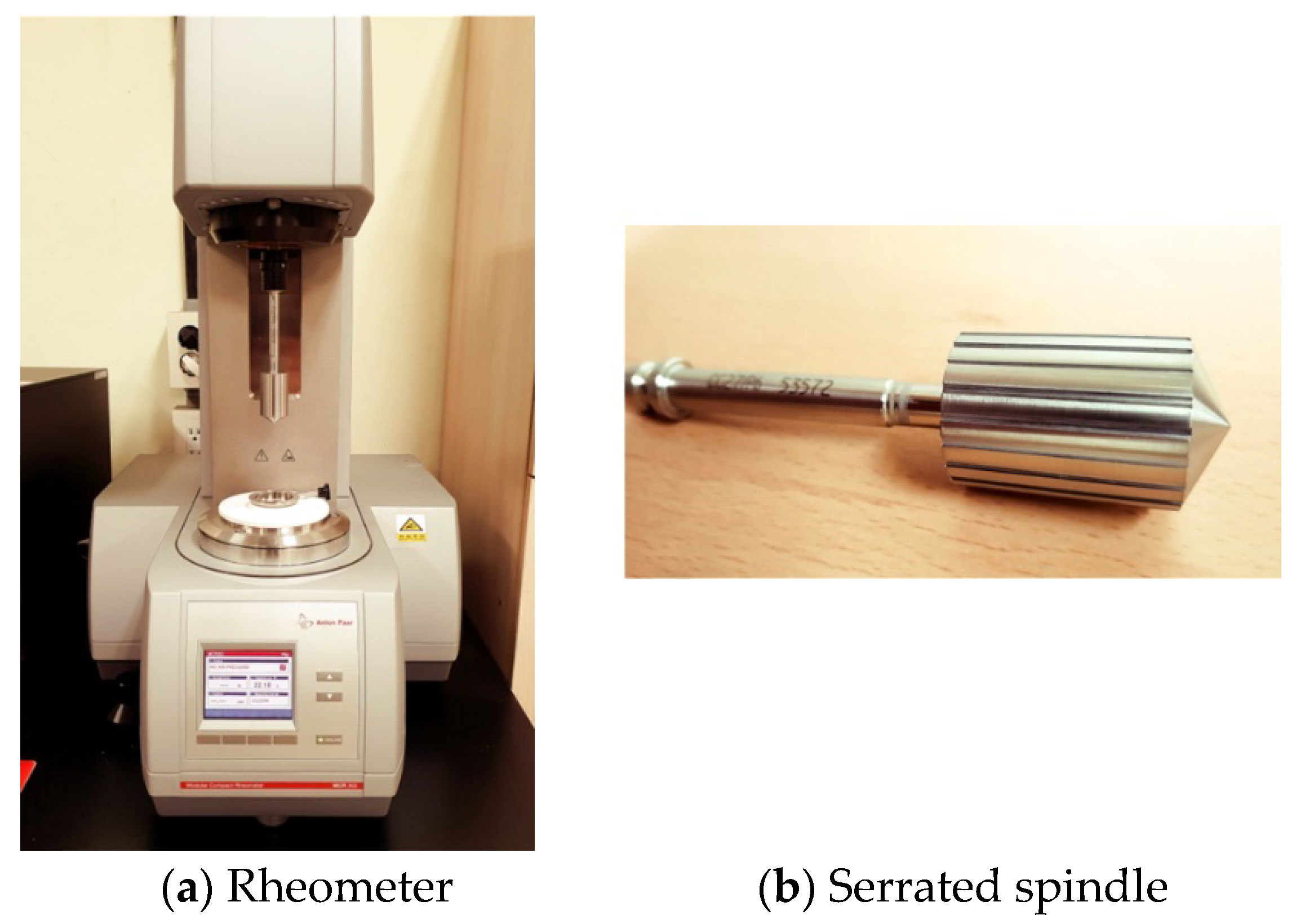
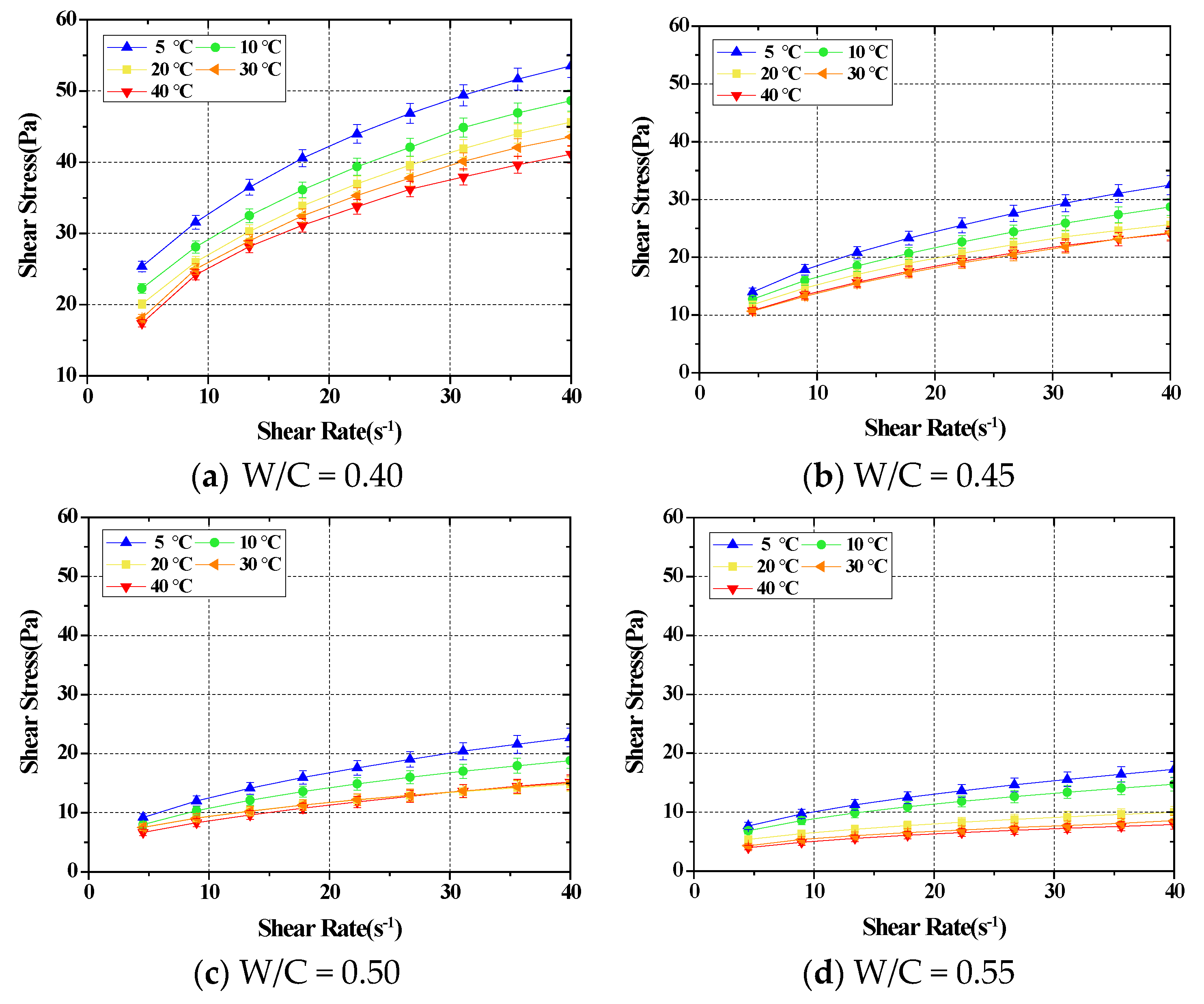
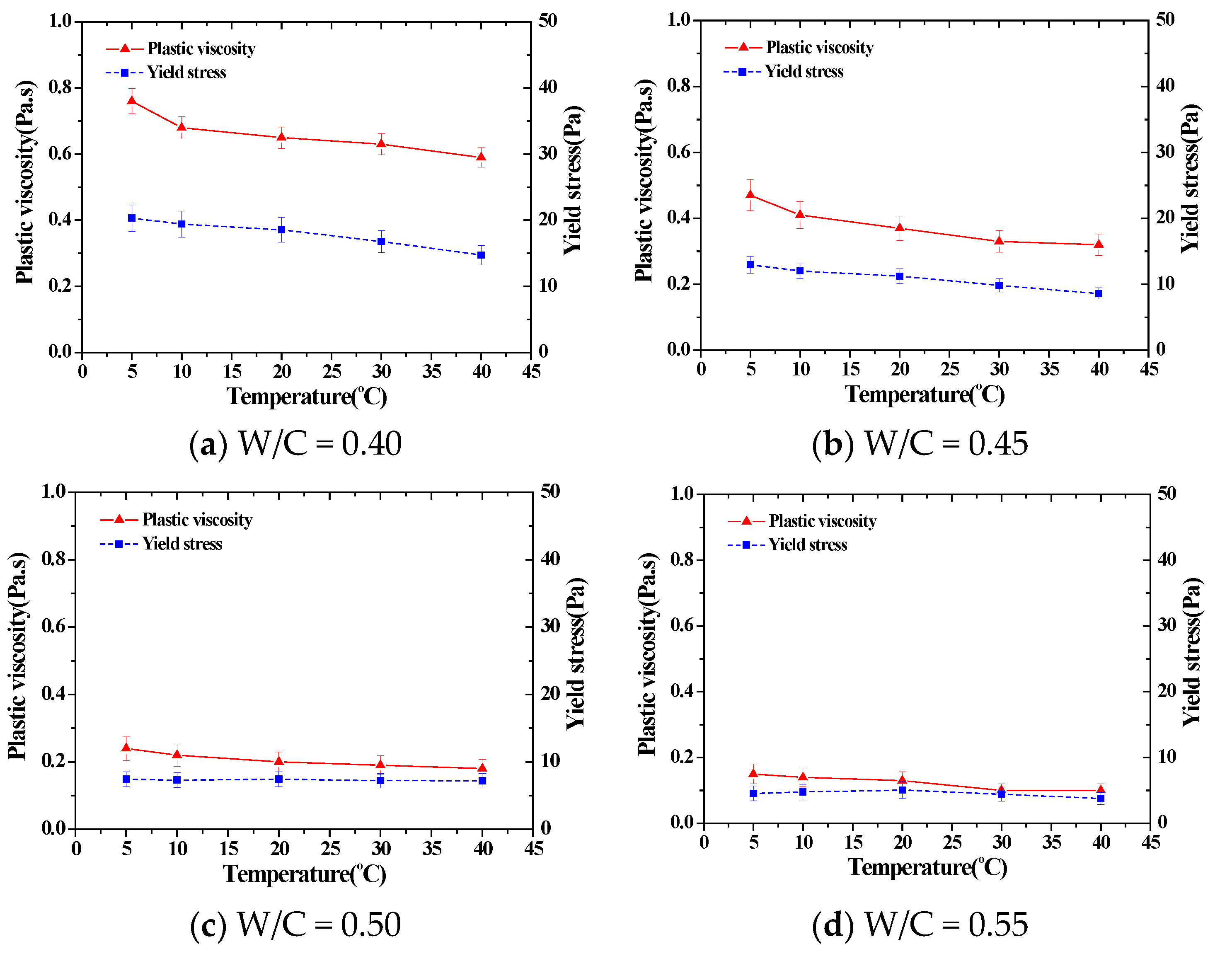
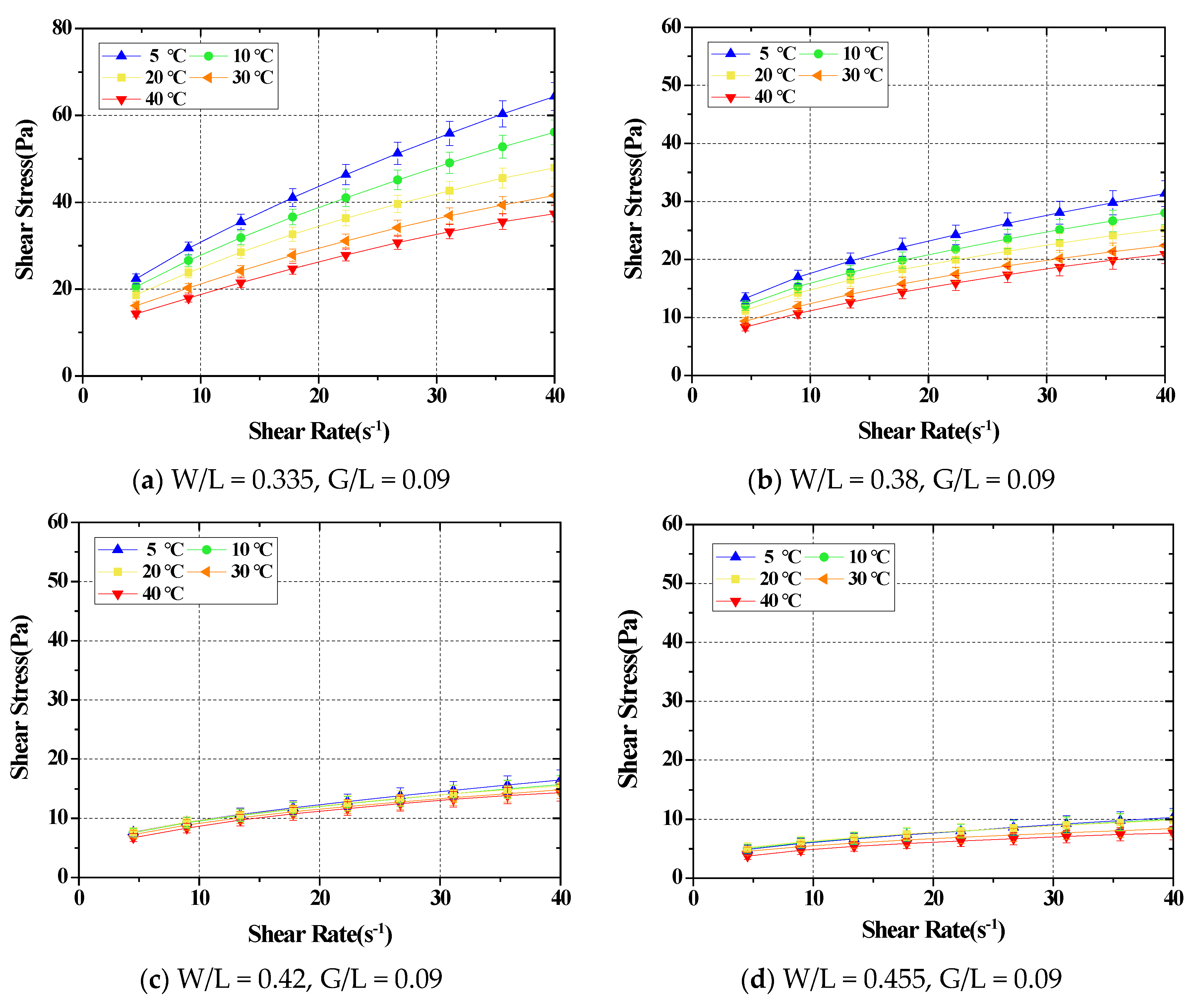
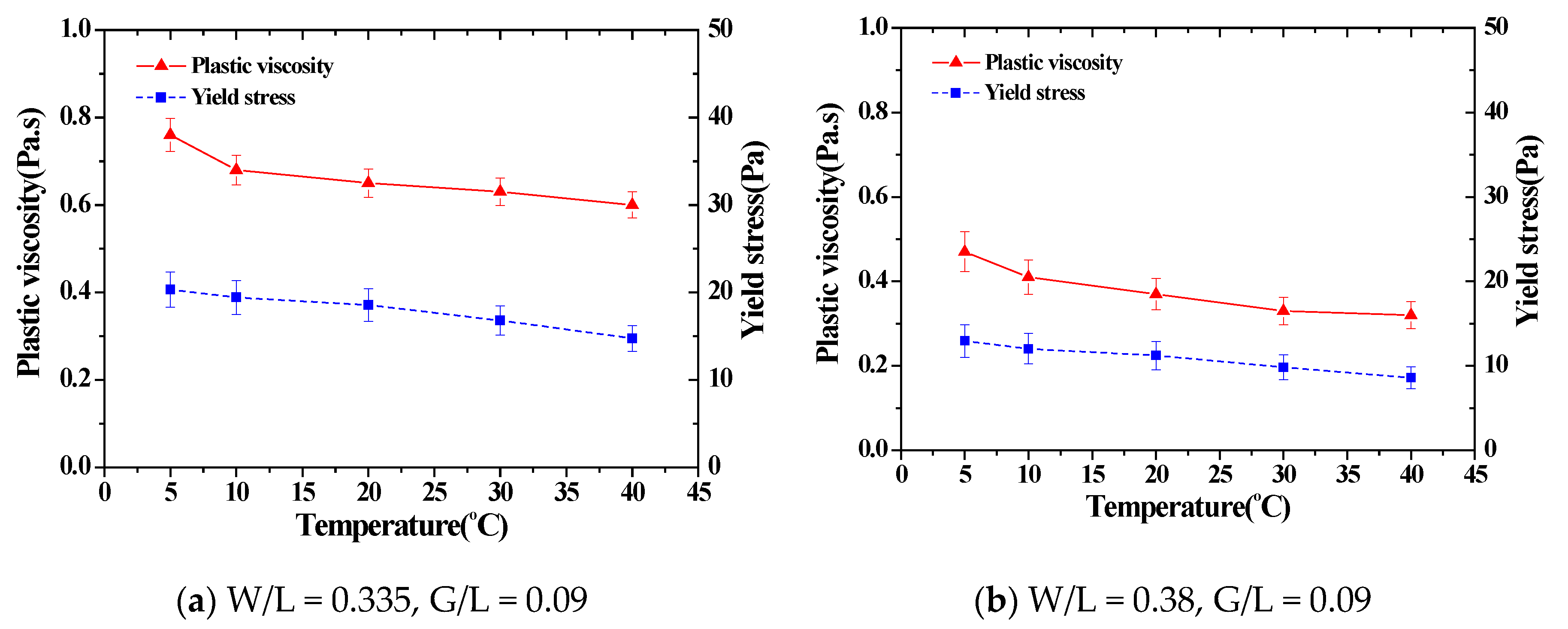
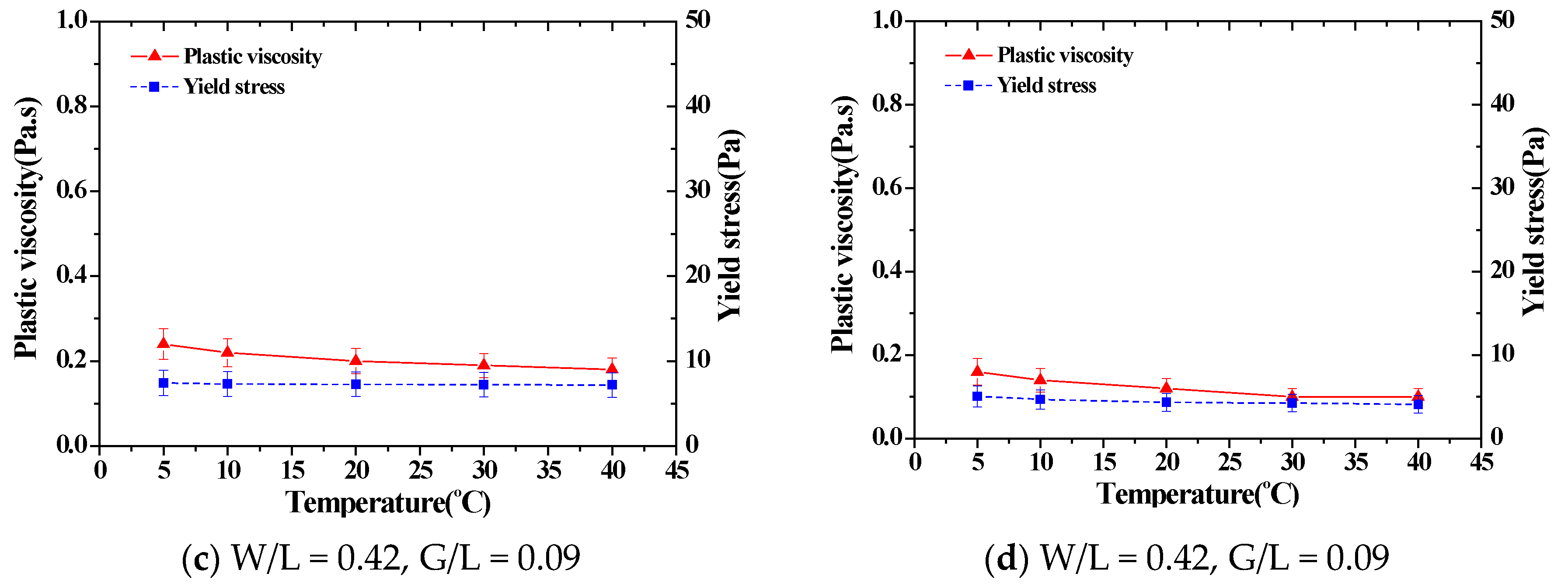
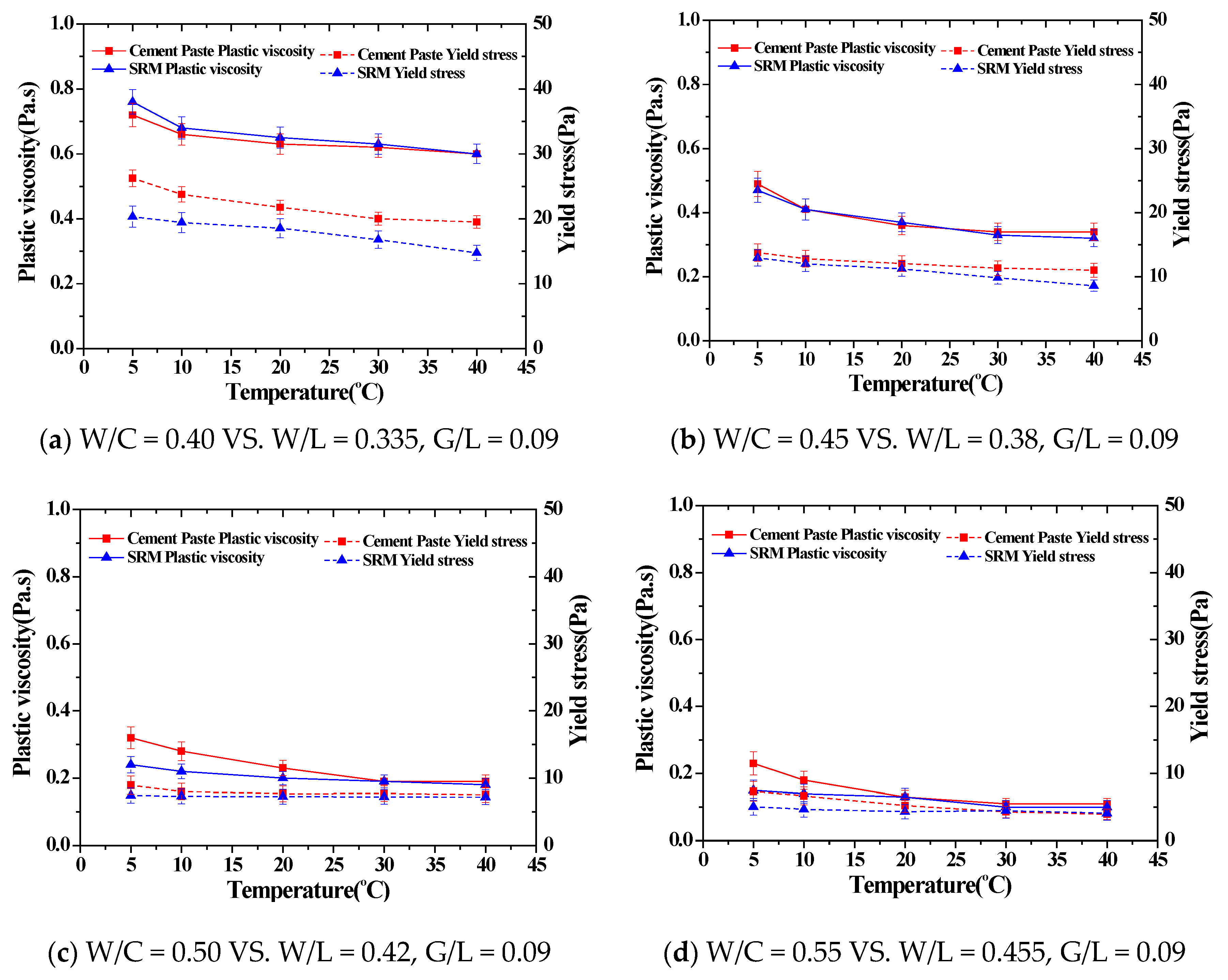
| Temperature (°C) | Cement Paste | |||||||
|---|---|---|---|---|---|---|---|---|
| W/C = 0.40 | W/C = 0.45 | W/C = 0.50 | W/C = 0.55 | |||||
| Plastic Viscosity (Pa·s) | Yield Stress (Pa) | Plastic Viscosity (Pa·s) | Yield Stress (Pa) | Plastic Viscosity (Pa·s) | Yield Stress (Pa) | Plastic Viscosity (Pa·s) | Yield Stress (Pa) | |
| 5 | 0.72 ± 0.1 | 26.23 ± 3 | 0.49 ± 0.1 | 13.77 ± 3 | 0.32 ± 0.1 | 8.96 ± 3 | 0.26 ± 0.1 | 7.35 ± 3 |
| 10 | 0.66 ± 0.1 | 23.77 ± 3 | 0.41 ± 0.1 | 12.81 ± 3 | 0.28 ± 0.1 | 8.03 ± 3 | 0.21 ± 0.1 | 6.67 ± 3 |
| 20 | 0.63 ± 0.1 | 21.78 ± 3 | 0.36 ± 0.1 | 12.04 ± 3 | 0.23 ± 0.1 | 7.68 ± 3 | 0.13 ± 0.1 | 5.25 ± 3 |
| 30 | 0.62 ± 0.1 | 20.02 ± 3 | 0.34 ± 0.1 | 11.35 ± 3 | 0.19 ± 0.1 | 7.72 ± 3 | 0.11 ± 0.1 | 4.29 ± 3 |
| 40 | 0.60 ± 0.1 | 19.52 ± 3 | 0.34 ± 0.1 | 11.02 ± 3 | 0.19 ± 0.1 | 7.54 ± 3 | 0.11 ± 0.1 | 3.95 ± 3 |
| Temperature (°C) | SRM | |||||||
|---|---|---|---|---|---|---|---|---|
| W/L = 0.335, G/L = 0.09 | W/L = 0.38, G/L = 0.09 | W/L = 0.42, G/L = 0.09 | W/L = 0.455, G/L = 0.09 | |||||
| Plastic Viscosity (Pa·s) | Yield Stress (Pa) | Plastic Viscosity (Pa·s) | Yield Stress (Pa) | Plastic Viscosity (Pa·s) | Yield Stress (Pa) | Plastic Viscosity (Pa·s) | Yield Stress (Pa) | |
| 5 | 0.76 ± 0.1 | 20.33 ± 3 | 0.47 ± 0.1 | 12.96 ± 3 | 0.24 ± 0.1 | 7.44 ± 3 | 0.15 ± 0.1 | 5.06 ± 3 |
| 10 | 0.68 ± 0.1 | 19.42 ± 3 | 0.41 ± 0.1 | 12.03 ± 3 | 0.22 ± 0.1 | 7.31 ± 3 | 0.14 ± 0.1 | 4.67 ± 3 |
| 20 | 0.65 ± 0.1 | 18.56 ± 3 | 0.37 ± 0.1 | 11.23 ± 3 | 0.20 ± 0.1 | 7.26 ± 3 | 0.13 ± 0.1 | 4.32 ± 3 |
| 30 | 0.63 ± 0.1 | 16.78 ± 3 | 0.33 ± 0.1 | 9.83 ± 3 | 0.19 ± 0.1 | 7.23 ± 3 | 0.10 ± 0.1 | 4.18 ± 3 |
| 40 | 0.60 ± 0.1 | 14.74 ± 3 | 0.32 ± 0.1 | 8.61 ± 3 | 0.18 ± 0.1 | 7.19 ± 3 | 0.10 ± 0.1 | 4.09 ± 3 |
© 2018 by the authors. Licensee MDPI, Basel, Switzerland. This article is an open access article distributed under the terms and conditions of the Creative Commons Attribution (CC BY) license (http://creativecommons.org/licenses/by/4.0/).
Share and Cite
Lee, D.K.; Choi, M.S. Standard Reference Materials for Cement Paste: Part III—Analysis of the Flow Characteristics for the Developed Standard Reference Material According to Temperature Change. Materials 2018, 11, 2001. https://doi.org/10.3390/ma11102001
Lee DK, Choi MS. Standard Reference Materials for Cement Paste: Part III—Analysis of the Flow Characteristics for the Developed Standard Reference Material According to Temperature Change. Materials. 2018; 11(10):2001. https://doi.org/10.3390/ma11102001
Chicago/Turabian StyleLee, Dong Kyu, and Myoung Sung Choi. 2018. "Standard Reference Materials for Cement Paste: Part III—Analysis of the Flow Characteristics for the Developed Standard Reference Material According to Temperature Change" Materials 11, no. 10: 2001. https://doi.org/10.3390/ma11102001
APA StyleLee, D. K., & Choi, M. S. (2018). Standard Reference Materials for Cement Paste: Part III—Analysis of the Flow Characteristics for the Developed Standard Reference Material According to Temperature Change. Materials, 11(10), 2001. https://doi.org/10.3390/ma11102001




